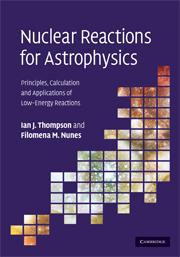Book contents
- Frontmatter
- Contents
- Preface
- Sources of quotations
- Acknowledgements
- 1 Nuclei in the Cosmos
- 2 Reactions of nuclei
- 3 Scattering theory
- 4 Reaction mechanisms
- 5 Connecting structure with reactions
- 6 Solving the equations
- 7 Approximate solutions
- 8 Breakup
- 9 Three-body nuclei
- 10 R-matrix phenomenology
- 11 Compound-nucleus averaging
- 12 Stellar reaction rates and networks
- 13 Connection to experiments
- 14 Spectroscopy
- 15 Fitting data
- Appendix A Symbols
- Appendix B Getting started with Fresco
- Select bibliography
- Index
13 - Connection to experiments
Published online by Cambridge University Press: 05 March 2012
- Frontmatter
- Contents
- Preface
- Sources of quotations
- Acknowledgements
- 1 Nuclei in the Cosmos
- 2 Reactions of nuclei
- 3 Scattering theory
- 4 Reaction mechanisms
- 5 Connecting structure with reactions
- 6 Solving the equations
- 7 Approximate solutions
- 8 Breakup
- 9 Three-body nuclei
- 10 R-matrix phenomenology
- 11 Compound-nucleus averaging
- 12 Stellar reaction rates and networks
- 13 Connection to experiments
- 14 Spectroscopy
- 15 Fitting data
- Appendix A Symbols
- Appendix B Getting started with Fresco
- Select bibliography
- Index
Summary
If your experiment needs statistics, you ought to have done a better experiment.
Ernest RutherfordMaking predictions for an experiment is much better achieved if the person performing the calculation is aware of the experimental details. In this chapter we therefore address some of the important issues to take into consideration when applying reaction theories. There is a wide variety of experiments related to astrophysics: the direct measurements (e.g. (p, γ), (n, γ), (α, γ) performed at low energy are obviously important, but there are also many indirect measurements (e.g. Coulomb dissociation method), a large fraction of which make use of higherenergy accelerators. Many of the forefront research experiments involve radioactive beams, while there are still important rates to determine using stable beams.
Since a large part of the research activity is taking place in rare-isotope facilities, we will first focus (Section 13.1) on some specifics of these facilities, where the exotic nuclei are produced, including both low- and high-energy laboratories. Next, Section 13.2 focuses on different aspects of present-day detectors that need to be considered when comparing calculations with data. Finally, in Section 13.3,we briefly mention some of the direct measurements involving less-exotic nuclei which are stable enough to be made into targets. Included are reactions with light chargedparticle beams (protons and alphas), neutron beams and photon beams.
New accelerators and their methods
Many of the recent leading studies in nuclear physics involve unstable nuclei. The first step in an experiment with radioactive beams is the production of the radioisotope of interest.
- Type
- Chapter
- Information
- Nuclear Reactions for AstrophysicsPrinciples, Calculation and Applications of Low-Energy Reactions, pp. 364 - 378Publisher: Cambridge University PressPrint publication year: 2009

